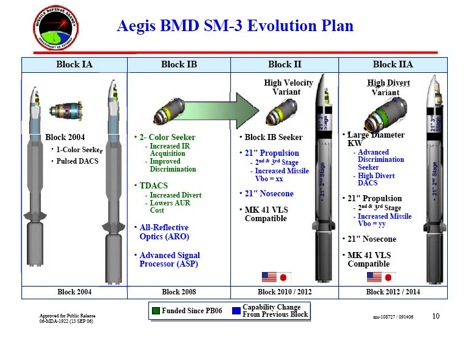by Ed Timperlake
“No Platform Fights alone”
U.S. and Allied Air/Sea fighting force is coming to fruition quickly.
The headlines following last week’s test of the SM-3 Block 1B missile were unambiguous and unanimous; the newest variant of the centerpiece of America’s missile defense shield was a resounding success.
 Looking back at an Aegis BMD Evolution Plan (2006) the US Navy keeps “just doing it” and doing it with continued success.
Looking back at an Aegis BMD Evolution Plan (2006) the US Navy keeps “just doing it” and doing it with continued success.
The wild card prior to the test was whether the Block 1B’s two-color infrared seeker would acquire, track and destroy the target missile utilizing the kinetic warhead.
The results of this ambitious technology were such that one observer noted, “The U.S. Navy lit up the sky,” over the Pacific and demonstrated that the Block 1B has what it takes to provide us with the missile shield we need, both for homeland defense and in Europe.
Too often, we hear about funding for questionable defense programs and ask ourselves whether we should invest tax dollars in missile systems that may or may not benefit the nation and its war fighters, a discussion we’ll save for another day.
But the elephant in the room right now regarding the SM-3 is the administration’s proposal to cut funding for Block 1B missile acquisition by more than 50%.
Had the Block 1B not lived up to its billing that would be one thing. But to reduce acquisition funding of this successful weapon defies logic.
Here we have a successful missile defense tool at our disposal, proven at sea and in the air, and capable of providing a workable missile shield.
Meanwhile, North Korea is working on its Plan B after last month’s failure of that regime’s newest long-range missile and Iran continues its saber rattling in the Persian Gulf despite renewed talks between the Islamic republic and the International Atomic Energy Agency.
The case to “just do it” could not be stronger or more apparent.
Inventories of the SM-3 in the fleet are insufficient and Navy commanders are telling Congress and the White House that they need more.
The Block 1B is a smashing success and we have growing threats in two theaters of operation.
It’s wrong to hamstring the Navy with budget cuts to proven weapon systems.
Given the high stakes associated with uncertainty in the Pacific and Persian Gulf, we do so at our peril.
This piece is the latest in our Forum publications on re-building the US military for the post-Afghanistan world.
These pieces can be found on the Second Line of Defense Forum. The Honorable Ed Timperlake is the Editor of the Forum

